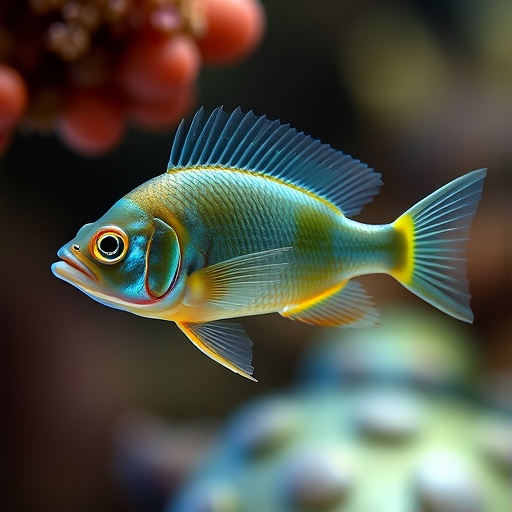In a groundbreaking discovery that illuminates the intricate relationships existing within freshwater ecosystems, researchers have identified a new species of parasitic flatworm within the genus Cosmetocleithrum, belonging to the Monopisthocotyla subclass of the family Dactylogyridae. This novel organism was found parasitizing the gills of Centromochlus heckelii, a species of catfish indigenous to the biodiverse Itaya River in Peru. This finding not only enriches our understanding of parasite biodiversity in South American rivers but also underscores the complex ecological dynamics at play in these freshwater habitats.
The investigation into this new species of Cosmetocleithrum was prompted by an extensive survey of parasitic fauna inhabiting neotropical fish species. Centromochlus heckelii, a member of the Auchenipteridae family known for its ecological adaptability and wide geographic distribution, served as the focal host organism for this study. The examination revealed morphological characteristics distinct enough to warrant the classification of a new species within the Cosmetocleithrum genus, enhancing the taxonomic resolution of these monogenean parasites.
Monogeneans, such as those within the Dactylogyridae family, are known for their highly host-specific parasitic behavior, often restricted to particular fish species and even specific organs like gills. These parasites play a pivotal role in aquatic ecosystems, affecting host population dynamics and health. The discovery of this new Cosmetocleithrum species contributes valuable data needed to understand host-parasite co-evolution and the ecological impacts of parasitism in freshwater fish populations.
Morphological analysis utilizing both light and scanning electron microscopy highlighted unique features in the newly described Cosmetocleithrum species. Detailed characterization of the haptoral armature, including the arrangement and morphology of hooks and anchors, distinguished this species from previously described congeners. Such fine-scale morphological differentiation is critical for accurate taxonomy and understanding the evolutionary relationships within Monopisthocotyla.
Molecular phylogenetics further complemented the morphological data, employing ribosomal DNA sequencing to elucidate the evolutionary lineage of the new Cosmetocleithrum species. Genetic markers confirmed its distinctiveness and helped place it accurately within the Dactylogyridae phylogenetic tree, underscoring the utility of integrative taxonomy in modern parasitology. This approach facilitates a more robust and reproducible species delineation critical for future systematic and ecological studies.
The ecological context of the Itaya River, part of the Amazon basin’s complex hydrological network, provides an exceptional backdrop for such discoveries. The rich biodiversity and varied microhabitats within the river create niches that foster a high degree of parasite-host specificity. Understanding the distribution patterns and host associations of monogenean parasites in this region sheds light on their role in freshwater fish health and ecosystem stability.
Parasitic monogeneans like Cosmetocleithrum species can influence fish behavior, physiology, and survival, with implications for fisheries and conservation biology. By identifying new species and mapping their host range, researchers can better assess the potential risks and benefits parasites impose on fish populations. This insight is especially valuable for managing native fish stocks and maintaining ecological balance in regions subject to environmental stressors and anthropogenic impacts.
The life cycle of monogenean parasites is often direct, with transmission occurring from fish to fish without intermediate hosts. This characteristic highlights the importance of host specificity and the potential for rapid parasite population responses to fluctuations in host abundance. Discovering new parasite species helps track these dynamics and can inform efforts to control parasitic infections in both wild and aquaculture settings.
Moreover, this research sheds light on the evolutionary strategies employed by monogeneans to adapt to their hosts. Structural adaptations of attachment organs, reproductive mechanisms, and immune evasion tactics reveal a complex arms race between parasite and host. Documenting these adaptations in new species contributes to a broader understanding of parasitic evolution and host defense mechanisms in aquatic environments.
Beyond taxonomy and ecology, the identification of this new Cosmetocleithrum species has broader implications for biodiversity conservation. Parasitic species are often overlooked in conservation policies, yet they serve as indicators of ecosystem health and complexity. Recognizing and cataloging parasite diversity enriches our appreciation of biological richness and informs sustainable management practices for aquatic ecosystems.
The meticulous work conducted by Morey, Pizango, Tapullima, and their colleagues highlights the importance of interdisciplinary collaboration in parasitology. Combining fieldwork, laboratory-based morphological studies, and molecular analyses offers a comprehensive approach that could set new standards for describing parasite diversity. It underscores a paradigm shift toward integrative methodologies in biological sciences.
As freshwater habitats continue to face threats from pollution, damming, and climate change, the urgency to document biodiversity, including parasitic species, grows ever stronger. Understanding parasite-host relationships offers crucial clues for predicting the responses of aquatic communities to environmental changes. Studies like this affirm the need for continued exploration and monitoring of parasitic biodiversity in vulnerable habitats like the Amazonian tributaries.
In conclusion, the discovery of a new Cosmetocleithrum species parasitizing Centromochlus heckelii in the Itaya River is a significant advancement in parasitology and freshwater biology. It enriches the taxonomic landscape, contributes to our understanding of host-parasite co-evolution, and highlights the complexity of freshwater ecosystems. This research opens the door for future investigations into the ecological roles of parasites and the conservation of their habitats, reminding us of the unseen biodiversity intricately woven into aquatic life.
Subject of Research: New species of parasitic monogenean flatworm Cosmetocleithrum from Centromochlus heckelii.
Article Title: New Species of Cosmetocleithrum (Monopisthocotyla: Dactylogyridae) from Centromochlus Heckelii (Osteichthyes: Auchenipteridae) from the Itaya River, Peru.
Article References:
Morey, G.A.M., Pizango, H.A.D., Tapullima, E.C. et al. New Species of Cosmetocleithrum (Monopisthocotyla: Dactylogyridae) from Centromochlus Heckelii (Osteichthyes: Auchenipteridae) from the Itaya River, Peru. Acta Parasit., 70, 212 (2025). https://doi.org/10.1007/s11686-025-01147-3
Image Credits: AI Generated
DOI: https://doi.org/10.1007/s11686-025-01147-3
Tags: aquatic ecosystem health impactsbiodiversity in South American riversCentromochlus heckelii catfishDactylogyridae family of parasitesecological relationships in fishfreshwater ecosystem dynamicshost-specific parasitic behaviorMonopisthocotyla subclassneotropical fish species surveynew species of Cosmetocleithrumparasitic flatworm discoverytaxonomic classification of monogeneans





